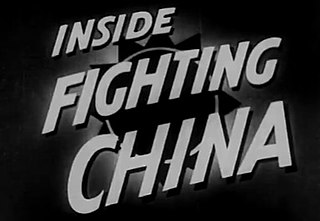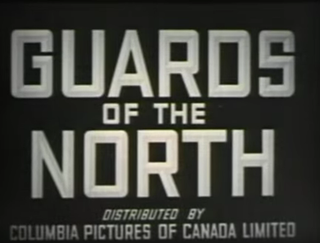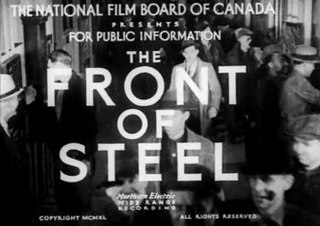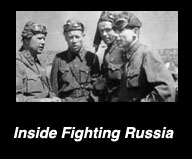
Fighting Norway is a 10-minute 1943 Canadian documentary, part of the wartime Canada Carries On series of short films produced by the National Film Board of Canada. The film was directed by Sydney Newman, one of a number of shorts that were intended for theatrical release.

Churchill's Island is a 1941 propaganda film chronicling the defence of Britain during the Second World War. The film was written and directed by Stuart Legg and produced by the National Film Board of Canada (NFB) for the Director of Information, Government of Canada.

Warclouds in the Pacific is a 20-minute 1941 Canadian documentary film, part of the Canada Carries On series of short films by the National Film Board of Canada. The film was produced, written and directed by Stuart Legg and narrated by Lorne Greene. Warclouds in the Pacific, which warned of an imminent Japanese attack, was released just one week before the attack on Pearl Harbor.

Inside Fighting China is a 1941 22-minute Canadian short documentary film produced by the National Film Board of Canada for distribution by United Artists, as part of the wartime The World in Action series. The film documents China's resistance to Japan's invasion during the Second World War. Inside Fighting China is directed by Stuart Legg, and narrated by Lorne Greene. The film's French version title is La Chine sous les armes.

Stuart Legg was a pioneering English documentary filmmaker. At the 14th Academy Awards in 1941, Legg's National Film Board of Canada film Churchill's Island became the first-ever documentary to win an Oscar.

Words for Battle is a British propaganda film produced by the Ministry of Information's Crown Film Unit in 1941. It was written and directed by Humphrey Jennings, and features seven sequences, each containing images of rural and urban Britain at war overlaid with audio commentary by Laurence Olivier, reciting passages from different English literary works and speeches.

Atlantic Patrol is a 1940 Canadian short documentary film, part of the Canada Carries On series of short films by the National Film Board of Canada, produced for the Office of Public Information.

Everywhere in the World is a 16-minute 1941 Canadian documentary film about the contributions of the United States and Commonwealth countries to the Allied war effort. The film was made by the National Film Board of Canada (NFB) as part of the wartime Canada Carries On series. It was produced by Stuart Legg. The film's French version title was Partout au monde.

Pincers on Japan(Piège à Nippon)is a 19-minute 1943 Canadian documentary film, made by the National Film Board of Canada (NFB). The film was directed by James Beveridge, who also produced and directed a similar NFB documentary, Look to the North (1944). Its companion film, Road to Tokyo, was produced in 1942.

The Home Front is a 10-minute 1940 Canadian documentary film, made by the National Film Board of Canada (NFB) as part of the wartime Canada Carries On series. The film was produced and directed by Stanley Hawes.

Guards of the North is a 10-minute 1941 Canadian documentary film, made by the National Film Board of Canada (NFB) as part of the wartime Canada Carries On series. The film, directed by Raymond Spottiswoode, documented the defences of Iceland during the Second World War. The film's French version title is Avant-garde du Nord.

The Battle of Brains is a 13-minute 1941 Canadian documentary film, made by the National Film Board of Canada (NFB) as part of the wartime Canada Carries On series. The film, directed by Stanley Hawes and produced by Stuart Legg, contrasted modern warfare with the First World War. The film's French version title is Sur le front scientifique.

U.N.R.R.A. presents In the Wake of the Armies ... is a 13-minute 1944 Canadian documentary film, made by the National Film Board of Canada (NFB) for the United Nations Relief and Rehabilitation Administration (UNRRA), as part of the wartime Canada Carries On series. The film, directed and edited by Guy Glover, described the work of the UNRRA during the Second World War and Canada's role in the relief agency. The film's French version title is À la suite de nos armées viendra l'entraide.

Inside Fighting Canada is an 11-minute 1942 Canadian documentary film, made by the National Film Board of Canada (NFB) as part of the wartime Canada Carries On series. The film, written and directed by Jane Marsh and produced by James Beveridge, was an account of the Canadian military during the Second World War. The film's French version is titled Canada en guerre.

The Front of Steel is an 11-minute 1940 Canadian documentary film, made by the National Film Board of Canada (NFB) as part of the wartime Canada Carries On series. The film, directed by John McDougall and produced by Stuart Legg, is an account of the value of steel in war production in Canada during the Second World War.

Inside Fighting Russia is a 1942 22-minute Canadian short documentary film produced by the National Film Board of Canada (NFB) for distribution by United Artists, as part of the wartime The World in Action series. The film documents Russia's fight against Nazi Germany during the Second World War. Inside Fighting Russia is produced by Stuart Legg, and narrated by Lorne Greene. The film's French version title is La Russie sous les armes.

The Battle for Oil is a 19-minute 1942 Canadian documentary film, made by the National Film Board of Canada (NFB) as part of the wartime Canada Carries On series. The film was produced by Raymond Spottiswoode and directed and edited by Stuart Legg.The Battle for Oil describes the strategic value of oil in modern warfare. The film's French version title was La Bataille du pétrole.

The Children from Overseas is a 10-minute 1940 Canadian documentary film, made by the National Film Board of Canada (NFB) as part of its Canada Carries On series.

The War for Men's Minds is a 21-minute 1943 Canadian documentary film, made by the National Film Board of Canada (NFB) as part of the wartime The World in Action series. The film was produced by Stuart Legg. The film describes the impact of propaganda from the Axis powers in 1943, during the Second World War. The French version title is À la conquête de l'esprit humain.

Pincer on Axis Europe is a 20-minute 1943 Canadian documentary film, made by the National Film Board of Canada as part of the wartime Canada Carries On series. The film describes the Allied invasion of North Africa in 1942 during the Second World War.




















